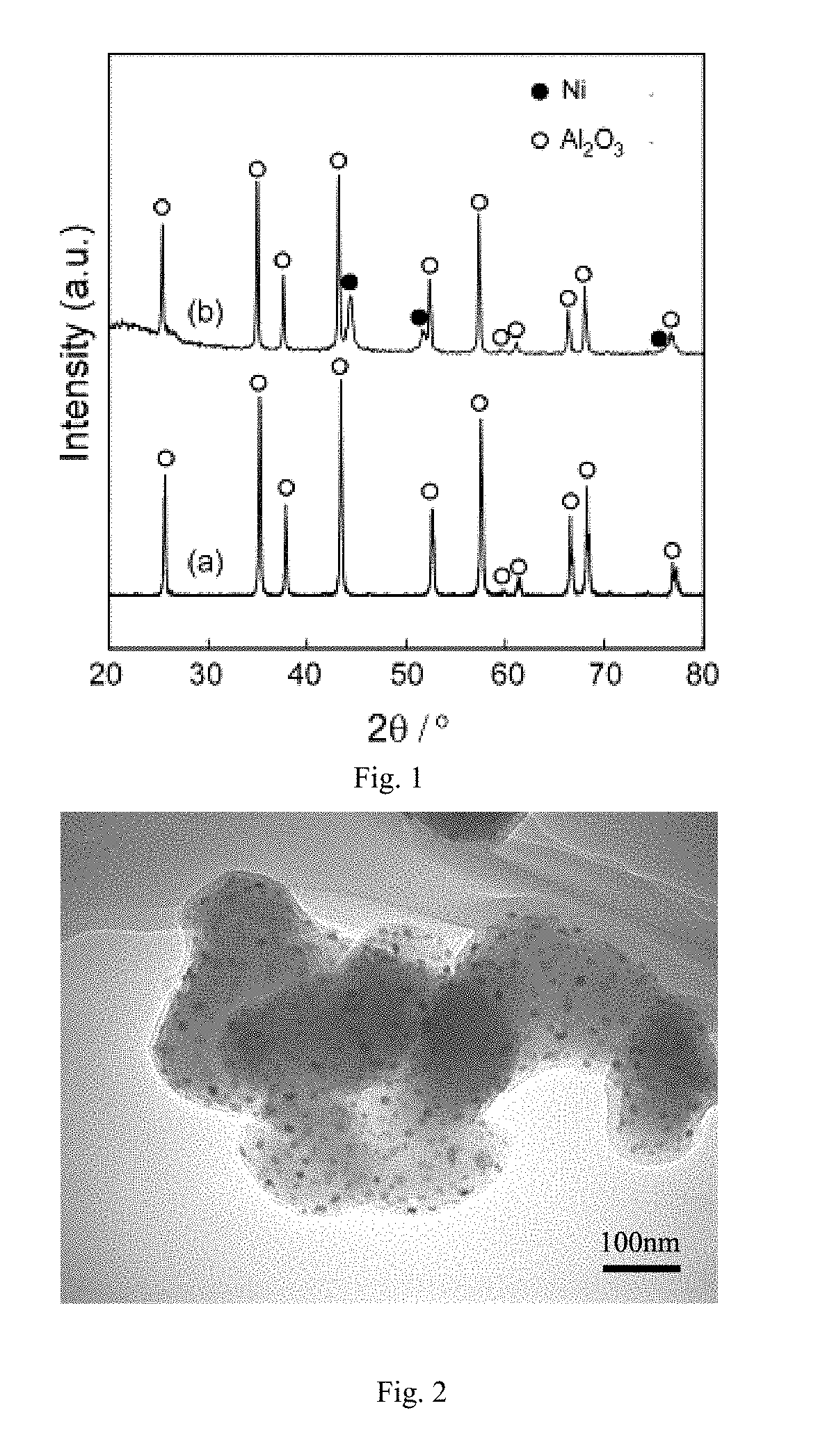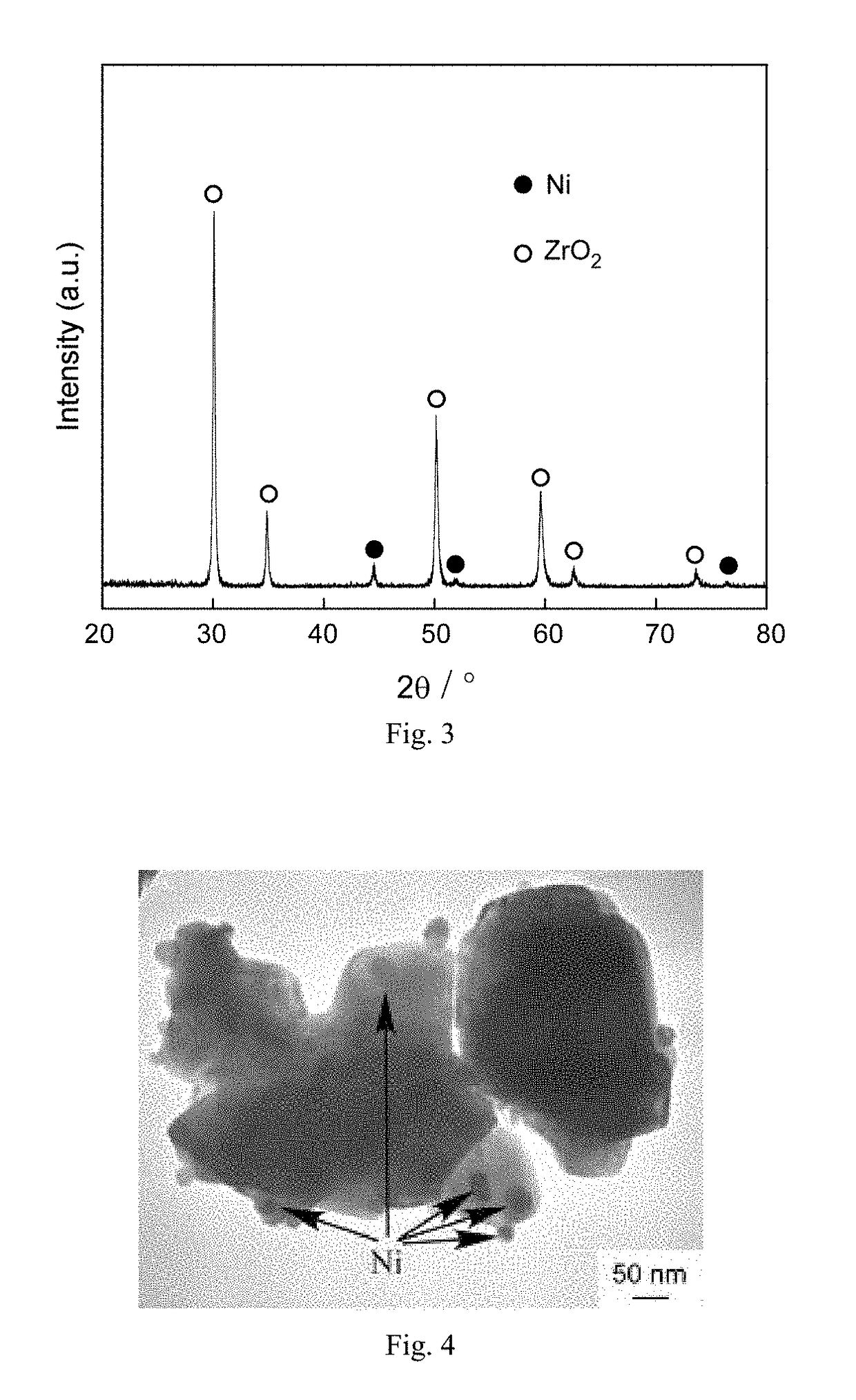Method for coating metal nanoparticles on oxide ceramic powder surface
- Summary
- Abstract
- Description
- Claims
- Application Information
AI Technical Summary
Benefits of technology
Problems solved by technology
Method used
Image
Examples
embodiment 1
[0024 Coat Ni nanoparticles on Al2O3 powder surface.
[0025]Firstly, 5 g ordinary commercial Al2O3 powder (the particle size was 500 nm) and 0.5 g Ni(CO)4 were mixed firstly, put into a rotational reactor, and then the reactor was rotated at a rotational rate of 45r / min. Mixed gas of oxygen and Ar was bubbled, wherein a total pressure of the mixed gas was 1000 Pa and a partial pressure of the oxygen was 100 Pa. The temperature was kept for 45 min after warming up to 450° C. at a heating rate of 8° C. / min, so that Ni(CO)4 was oxidized into nickel oxide, then an oxygen supply valve was closed, and carbonic oxide was bubbled to reduce the metal oxide (nickel oxide) into nanoparticles in a metallic state. A partial pressure of the carbonic oxide was 200 Pa, the reduction reaction time was 45 min, and then the temperature was cooled at a cooling rate of 8° C. / min. The gas valve was closed after the temperature was cooled to a room temperature, the rotation and heating of the reactor were s...
embodiment 2
[0026 Coat Cu nanoparticles on Al2O3 powder surface.
[0027]Firstly, 5 g ordinary commercial Al2O3 powder (the particle size was 100 nm) and 2 g Cu(DPM)2 (copper dipivaloylmethanate) were mixed firstly, put into a rotational reactor, a feeding valve of the rotational reactor was closed, and the rotational reactor was started up to rotate at a rotational rate of 60r / min. Next, mixed gas of oxygen and argon gas was bubbled, wherein a total pressure of the mixed gas was 800 Pa and a partial pressure of the oxygen was 50 Pa. A heating rate was set as 5° C. / min, the temperature was kept for 60 min after warming up to 400° C., so that Cu(DPM)2 was oxidized into cupric oxide, then an oxygen supply valve was closed, and methane was bubbled to reduce a metal oxide CuO into nanoparticles in the metallic state. A partial pressure of the methane was 100 Pa, the reduction reaction time was 60 min, and then the temperature was cooled at a cooling rate of 5° C. / min. A carbonic oxide inlet valve and ...
embodiment 3
[0028 Coat Ni nanoparticles on ZrO2 powder surface.
[0029]Firstly, 5 g ordinary commercial ZrO2 powder (the particle size was 10 μm) and 5 g NiCp2 (nickelocene) were blended, put into a rotational reactor, and then the reactor was rotated at a rotational rate of 15r / min. Mixed gas of oxygen and Ar was bubbled, wherein a total pressure of the mixed gas was 800 Pa and a partial pressure of the oxygen was 200 Pa. The temperature was kept for 30 min after warming up to 450° C. at a heating rate of 7° C. / min, so that NiCp2 was oxidized into NiO, then an oxygen supply valve was closed, and hydrogen was bubbled to reduce a metal oxide NiO into nanoparticles in a metallic state. A partial pressure of the hydrogen was 400 Pa, the reduction reaction time was 30 min, and the temperature was cooled at a cooling rate of 7° C. / min. The gas valve was closed after the temperature was cooled to a room temperature, the rotation and heating of the reactor were stopped, then the reactor was opened, the ...
PUM
| Property | Measurement | Unit |
|---|---|---|
| Temperature | aaaaa | aaaaa |
| Fraction | aaaaa | aaaaa |
| Partial pressure | aaaaa | aaaaa |
Abstract
Description
Claims
Application Information
 Login to View More
Login to View More - R&D
- Intellectual Property
- Life Sciences
- Materials
- Tech Scout
- Unparalleled Data Quality
- Higher Quality Content
- 60% Fewer Hallucinations
Browse by: Latest US Patents, China's latest patents, Technical Efficacy Thesaurus, Application Domain, Technology Topic, Popular Technical Reports.
© 2025 PatSnap. All rights reserved.Legal|Privacy policy|Modern Slavery Act Transparency Statement|Sitemap|About US| Contact US: help@patsnap.com


